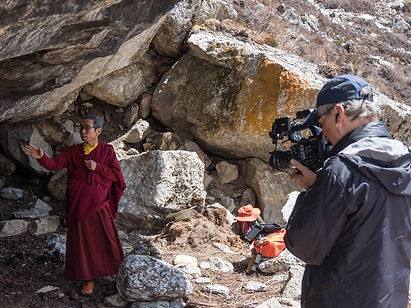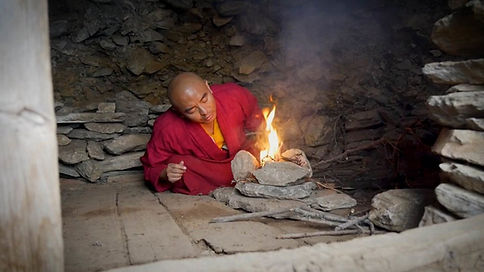

About the film
Celebrated Tibetan Buddhist Meditation Master Mingyur Rinpoche walks away from his life of comfort to live that of a wandering yogi, spending 4½ years incognito on the streets of India, Nepal and in Himalayan caves. He returns to share insights gained into the true nature of our minds.

Under cover of darkness and with no word of his plans, much-beloved Tibetan Buddhist Meditation Master Yongey Mingyur Rinpoche walked away from his life on the international stage to live that of a wandering yogi. Unheard of among eminent teachers today, such a practice is rife with hardships. For Mingyur Rinpoche, these challenges—begging, finding food and shelter, illness, and all the attendant risks of wandering incognito from place to place with the barest of possessions—present fertile ground for deepening insight into the true nature of the mind.
Wandering . . . But Not Lost is an intimate account of Rinpoche's four-and-a-half-year retreat (June 2011 – November 2015) interspersed with the master’s own guidance in applying Buddhist wisdom to our daily modern lives.
The story begins in Bodhgaya, India at the monastery of this renowned meditation master and teacher, best-selling author, and abbot of three monasteries worldwide. Recounting the night of his disappearance in detail, the film follows Rinpoche through his first days and weeks, including his near-death experience and the insight he gains as a result.
In vibrant and sweeping footage, WNL then traces his path—by foot, bus, train, and rickshaw—over the plains of northern India and into the mountains, hermitages, and caves of the Himalayas. Along the way, Rinpoche shares the wisdom he gained from these experiences in candid insights.
The story turns when Tashila, long-time attendant and friend of Rinpoche, spots him in Kathmandu at the Great Stupa of Boudhanath. Tashila, filled with inspiration, implores Rinpoche to allow him to join him. Rinpoche refuses at first, but when Tashila agrees to commit to a three-year wandering retreat, Rinpoche consents. The gain is ours: Tashila provides audiences a window into Rinpoche’s compassion and kindness for others. He recounts the yogi’s interactions with strangers in which he offers meditation techniques and Buddhist philosophy to anyone who asks or shows interest.
Layered over this story is exotic footage of ancient and holy places, such as Langtang, Nubri, Dolpo, and Lapchi where Tibet’s most famous yogi and poet Jetsun Milarepa (1052-1135) lived in solitary meditation. Kushinagar, where the Buddha passed away, Varanasi, Rishikesh, Ladakh, and Amritsar are also featured, along with one of the holiest Hindu shrines on the subcontinent: Vaishno Devi, reached by an arduous 14-kilometer hike up a mountain path full of joyous Hindu pilgrims.
“The entire path is a shift in perception,” says Mingyur Rinpoche. These and other words of wisdom culled from his extraordinary wandering retreat and devoted adherence to his meditative practice will touch—and inspire—audiences everywhere.
Watch the Official Trailer Here
DIRECTOR'S NOTES




We were all really excited when Rinpoche returned from his 4½ year wandering retreat in November 2015. In the previous months I had put most my belongings in a storage locker and headed to Kiev, Ukraine to finish my other film, A Joyful Mind. No one knew when Rinpoche would return, so after Kiev I was going to go to Kathmandu and wait for him. I was still in Ukraine when we received word of his return, and a group of us went to Delhi to meet with him. Everyone was very happy to see him. He had lost a lot of weight, was darker from the sun, and had long hair, and though dramatic, these were only the most obvious indications of his long and difficult journey.
I traveled with him over the next several weeks in India first to meet his teacher Tai Situ Rinpoche in Himachal Pradesh then on to Nepal. His family had already flown to Bodh Gaya, where he resurfaced, to meet with him there. At first making a film about his retreat was not on my mind at all. I had just finished A Joyful Mind, which took me 6 years, so working on another film right away wasn’t on my radar. That is until the stories started flowing and I became very inspired by all that Rinpoche went through. Then when he told about his near death experience in Kushinagar, I strongly felt that this would make a great film. As I started to gain enthusiasm at the prospect, I heard from someone that he was approached about writing a book on his retreat and his reply was, “maybe in ten years”. My heart sank but I was still happy that he was alive and healthy, and that I would be filming teachings with him anyway. Then a few days later I decided to ask him if I could make a film on his retreat regardless, fully expecting him to decline. I explained what I had in mind and when he replied “Good idea!” I was pleasantly shocked and immediately began working on it. Of course his new book will be out soon but that is about the Bardos and is focused on the first 3 weeks of his retreat.
Now it’s over three years later and I’ve been living in Kathmandu, having made numerous trips to India and around Nepal, and spent months in the villages, cities and mountains of both countries to film where Rinpoche spent his time. Sometimes it wasn’t easy to know exactly where he was. A lot of time had passed and those details weren’t really so important to Rinpoche. He was much more focused on experience than on dates and locations. One thing I can say for sure is that I have even more respect for Rinpoche and am even more inspired by his journey after visiting some of these places and finding them challenging, hearing his stories, and learning about how he spent his time there.
I’m eager to share these experiences with you.
This website will be updated often with stories and photos from the making of the film of Rinpoche’s retreat as I have time to post them. The editing is going really well so I have to tear myself away from it to focus on anything else.
A partial list of where I’ve filmed:
India
Bodh Gaya, Gaya train station, Varanasi, Kushinagar, Shravasti, Tso Pema, Ayodhaya, Srinigar, Jammu, Ladakh (Leh and Nubra Valley).
Nepal
Kathmandu, Dolpo, Lapchi, Langtang, Yolmo
We'd like to thank all the people who contributed to help make it successful!
To bring Wandering . . . But Not Lost to more viewers around the world, we need your support. As world-renowned neuroscientist Dr. Richard J. Davidson writes:
“[Wandering] is the most moving account of the wisdom of the Buddhist path that I’ve seen, and anyone with an interest in meditation and human flourishing will be nourished by viewing it.”
Thank you!


Giving & Tax Benefits
A Joyful Mind, LLC is wholly-owned "limited liability company" of Tergar International, a tax-exempt 501(c)3 non-profit organization. Therefore, your contribution to A Joyful Mind is tax-deductible to the fullest extent of the law.